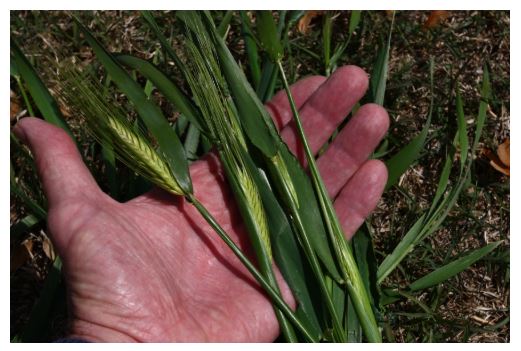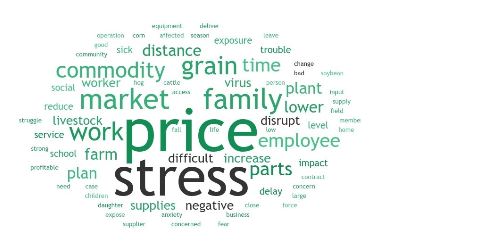 |
We invite you to listen to us on great radio stations across the region on the Radio Oklahoma Network weekdays- if you missed this morning's Farm News - or you are in an area where you can't hear it- click here for this morning's Farm news from Ron Hays on RON.
Let's Check the Markets!
OKC West is our Market Links Sponsor- they sell cattle three days a week- Cows on Mondays, Stockers on Tuesday and Feeders on Wednesday- Call 405-262-8800 to learn more.
Today's First Look:
mornings with cash and futures reviewed- includes where the Cash Cattle market stands, the latest Feeder Cattle Markets Etc.
Oklahoma National Stockyards had over 6,000 head on Monday- and HIGHER prices- click here for the complete set of details from USDA Market News.
Okla Cash Grain:
Joplin Regional Stockyards reported over 5,000 head with steady to higher prices on Monday- click here for all the details.
Futures Wrap:
Feeder Cattle Recap:
Slaughter Cattle Recap:
TCFA Feedlot Recap:
Our Oklahoma Farm Report Team!!!!
Ron Hays, Senior Farm Director and Editor
KC Sheperd, Associate Farm Director and Editor Sam Knipp, Farm Editor Pam Arterburn, Calendar and Template Manager Dave Lanning, Markets and Production
|
|
|
Oklahoma's Latest Farm and Ranch News
Your Update from Ron Hays of RON
Tuesday, April 21, 2020
|
Howdy Neighbors!
Here is your daily Oklahoma farm and ranch news update.
|
There's finally a small bit of good news in the struggle over keeping meat packing and processing plants open in the face of coronavirus infection and resulting employee absences.
Tyson Fresh Meats Inc. has signaled that they will resume limited operations at its pork plant in Columbus Junction, Iowa, on Tuesday after being idle for two weeks due to COVID-19 concerns, and also at its Perry, Iowa pork plant, closed for one day for cleaning.
In a news release, Tyson Fresh Meats President Dean Banks says "We plan to increase production at Columbus Junction gradually, with the safety of our team members top of mind."
This past week- Smithfield Foods announced the closure of its Sioux Falls hog plant indefintely followed by downstream facilities that processed some of that plant's output. The most immediate was probably its Martin City, Mo., plant that processed hams, which will close indefinitely. The company's Cudahy, Wisconsin, dry sausage and bacon plant will close for at least two weeks.
By the way- the Smithfield plant in South Dakota is the ninth largest pork processing plant in the US- to give you some context- the Seaboard plant in Guymon is the sixth largest plant in the country.
****************
Staying with the situation related to pork- the Daily Livestock Report detailed the incredible drop in prices-
"The national weighted average base slaughter hog carcass price fell 19.8%, to $52.55 per cwt from $65.55, over the past two weeks, the lowest level since reaching about $50 per cwt in September 2018. "The pork cutout value has seen an even sharper decline, to levels not touched since October 2009, dropping 32.4% over two weeks to $53.55 from $79.20. The pullback has hit most pork primal values, with the tenderloin being the exception. Pork loin prices are up 38.1% to $90.30 per cwt in just eight weeks, as consumers purchased meat for home consumption. "This is in contrast to sharp declines in just two weeks for the butt (down 56.7%), picnic (down 52.6%), and rib (down 42.8%). Ham prices are down 44.0% to $35.05 per cwt in five weeks, and belly prices declined 69.0% to $34.54 per cwt over 10 weeks."
*****************
Dr. Jayson Lusk- formerly an Ag Econ Professor at OSU- and now the head of the Ag Economics Department at Purdue- tweeted last night "A Minnesota JBS pork processing plant just closed due to COVID; add that to the Smithfield plant in SD, and that's more than 8% of the nation's processing capacity down; add in the one-day Tyson plant shutdown in IN, that's 11% of total capacity."
Dr. Lusk will be featured in a FarmDoc Webinar this morning at 11 AM central- click here for more details and to register if you want to tune in.
*****************
Finally- on the Beef side of things- the Greeley JBS plant remains closed for a few more days due to coronavirus while
Cargill has reduced production at Fort Morgan, Colroado to one shift
National Beef has had some slowdowns at their plants but no complete shutdowns as of yet, and that includes their plants in Liberal and Dodge City, Kansas. On their website. National details what they are doing to try to keep the plants open- National Beef Packing Company is screening staff for fevers, and anyone whose temperature is 100.4 degrees or higher is sent home. Those individuals are not allowed to return to work until they have had 72 consecutive hours without a fever. Disposable masks and face shields are available for employees, and stainless steel partitions have been added to production areas, according to the website. Other safety measures at National Beef facilities include increased cleaning and sanitizing and instituting procedures that allow drivers to stay in their trucks while on-site
|
|
|
Sponsor Spotlight
The Oklahoma Cattlemen's Association is the trusted voice of the Oklahoma Cattle Industry. With headquarters in Oklahoma City, the OCA has a regular presence at the State Capitol to protect and defend the interests of cattlemen and cattlewomen.
Their Vision Statement explains the highest priority of the organization- "Leadership that serves, strengthens and advocates for the Oklahoma cattle industry."
To learn more about the OCA and how you can be a part of this forward-looking group of cattle producers, click here for their website. For more information- call 405-235-4391.
|

In Oklahoma wheat headed reached 28 percent, up 18 points from the previous year but down 2 points from normal.
Corn planted reached 10 percent, down 16 points from the previous year and down 20 points from normal. Soybeans planted reached 3 percent. Pasture and range conditions were rated at 62 percent good to excellent- up significantly from 54% good to excellent a week ago.
In Kansas, the wheat condition is rated 46 percent good to excellent this week (50 percent last week),36 percent is fair (about the same as last week) and 18 percent is rated poor to very poor this week compared to 15 percent last week.
The Texas wheat crop this week is 58 percent rated good to excellent, (compared to 66 percent last week), 30 percent is rated fair (26 percent last week) and 12 percent in the poor to very poor category (8 percent last week).
|
With losses mounting, livestock producers were pleased to learn over the weekend that federal relief funds are headed their way. However, relief could be a month away. Colin Woodall, CEO of the National Cattlemen's Beef Association, talked with me over the weekend and expressed optimism about the coronavirus food assistance program.
We appreciate USDA Sec. Perdue rolling this out, Woodall said. The good news is we received $5.1 billion, the majority of the $9.5 billion total included in the CARES Act passed earlier by Congress, Woodall said.
He noted this will not fill all the gaps, but we realize the secretary is trying to do everything to get as much money to as many people as possible.
|

Stress levels are high among America's soybean farmers, so much so that the terms "stress," "anxiety," and "concerns over mental health" were used dozens of times in an informal survey released this week by the American Soybean Association (ASA).
The survey was an initiative of the ASA COVID-19 Task Force, a 12-person group formed in March consisting of ASA board members and senior staff, state affiliate leaders, and a representative from sister soybean organizations United Soybean Board (USB) and U.S. Soybean Export Council (USSEC). It was sent to approximately 140 farmer leaders serving on the boards of ASA, USB and USSEC, with 60% of those persons participating. In many cases, as with feeling stressed and the need for improved internet access in rural America, the consensus was clear.
Ryan Findlay, CEO of ASA responded, "We were struck immediately by how many respondents talked openly about the high levels of stress and anxiety on their farms. Fear at smaller operations that critical workers will get sick, concerns over taking care of elderly parents and children not able to attend bricks-and-mortar classrooms right now, worries over workers scared they will get sick not showing up-and that's only the important human aspect before you even get into prices, loan access and aid concerns, input delays and a host of problems hitting tangential industries like pork, beef, poultry, and dairy on which our industry relies."
|
|
Sponsor Spotlight
National Livestock was founded in 1932 in Oklahoma City. National's Marketing Division offers cattle for sale weekly at the Oklahoma National Stockyards in Oklahoma City. The Finance Division lends money to ranchers across several states for cattle production. The Grazing Division works with producers to place cattle for grazing on wheat or grass pastures. National also owns and operates other livestock marketing subsidiaries including Southern Oklahoma Livestock Auction in Ada, Oklahoma, OKC West Livestock Market in El Reno, Oklahoma, and the nation's premier livestock video sale, Superior Livestock Auction. National offers customers many services custom made for today's producer. To learn more, click here for the website or call the Oklahoma City office at 1-800-310-0220.
|
Mondays, Dr. Derrell Peel, Oklahoma State University Extension Livestock Marketing Specialist, offers his economic analysis of the beef cattle industry. This analysis is a part of the weekly series known as the "Cow Calf Corner" published electronically by Dr. Peel and Dr. Glenn Selk. Today, Dr. Peel talks about USDA offering help for the cattle industry.
Last week, USDA announced a total of $19 billion for the Coronavirus Food Assistance Program (CFAP). The program includes $16 billion in direct payments to farmers and ranchers including $9.5 billion of emergency funding from the CARES Act and $6.5 billion of funding from the Commodity Credit Corporation (CCC). Additionally, CFAP includes $3 billion in purchases of meat, dairy and produce to support producers and provide food assistance to those in need. CFAP is funded from the Coronavirus Aid, Relief and Economic Security Act (CARES), the Families First Coronavirus Response Act (FFCRA) and other USDA programs.
The beef cattle industry will receive $5.1 billion of CFAP funding to partially offset 2020 losses due to COVID-19. Cattle producers will receive a single direct payment determined by two calculations including 85 percent of price losses from January 1- April 15, 2020 and 30 percent of expected losses for two quarters after April 15. In order to qualify, commodities must have experienced at least a five percent price decrease between January and April. USDA expects to begin sign-up in early May and distribute payments by late May or early June.
|
On Friday, U.S. Secretary of Agriculture Sonny Perdue announced the $19 billion Coronavirus Food Assistance Program. The program is intended to support America's farmers and ranchers amid the COVID-19 pandemic. The agriculture industry, already reeling from trade war fallout, has lost billions due to plummeting prices, sudden drops in demand and supply chain weaknesses, and AFR/OFU Cooperative president Scott Blubaugh says he's very disappointed in the relief plan.
Radio Oklahoma Ag Network Associate farm director, KC Sheperd spoke with Blubaugh, and he expressed that there will need to be more money, "When we got the details on how they are going to spend that money, it's just totally inadequate."
Blubaugh says the program will not do much for the producers in the dairy business and the farmers and ranchers who have suffered greatly from this market disruption. He says the money at best is about 1/3 of what it should be in order to make producers somewhat whole, "The dollars lost in the cattle business is around 14 billion dollars, so the funding is very inadequate at 5.1 billion for the entire cattle industry, so it's going to do very little for any of our commodity groups."
|
As the COVID-19 pandemic and crude oil glut continue to ravage world fuel markets, U.S. ethanol sales in 2020 could fall by more than $10 billion and the industry's contribution to gross domestic product (GDP) could drop by nearly one-third, according to a new analysis released today by the Renewable Fuels Association (RFA). The economic losses stem from a "pernicious combination of steep production cuts and sharply lower prices" in response to COVID-19 stay-at-home orders and the resulting collapse in fuel consumption, according to the report.
RFA warned that these economic damages go far beyond the ethanol sector. America's farmers will also be negatively impacted, as ethanol typically provides a market for two out of every five rows of corn and more than one-third of the annual sorghum crop. Meanwhile, the industry normally supports 350,000 jobs across all sectors of the economy, and contributes valuable co-products like distillers grains, corn distillers oil, and captured carbon dioxide to the food supply chain.
Building on the results from a recent Purdue University study, the RFA analysis estimates that ethanol production could fall by approximately 3 billion gallons in 2020, representing a nearly 20 percent cut from levels that would have otherwise been expected. Mainly due to lower usage and high inventories, ethanol prices could be 56 cents per gallon lower on average from March to December than they otherwise would have been; as a result, ethanol sales fall to $12.5 billion in 2020, a 46 percent reduction from the $23 billion that would have been expected absent COVID-19.
|
|
Our thanks to Midwest Farms Shows, P & K Equipment, AFR Insurance, Oklahoma Farm Bureau, Stillwater Milling Company, National Livestock Credit Corporation, Oklahoma Beef Council, Oklahoma AgCredit, the Oklahoma Cattlemens Association and KIS Futures for their support of our daily Farm News Update. For your convenience, we have our sponsors' websites linked here- just click on their name to jump to their website- check their sites out and let these folks know you appreciate the support of this daily email, as their sponsorship helps us keep this arriving in your inbox on a regular basis- at NO Charge!
We also appreciate our Market Links Sponsor - OKC West Livestock!
We invite you to check out our website at the link below too that includes an archive of these daily emails, audio reports and top farm news story links from around the globe.
God Bless! You can reach us at the following:
phone: 405-473-6144
|
|
|